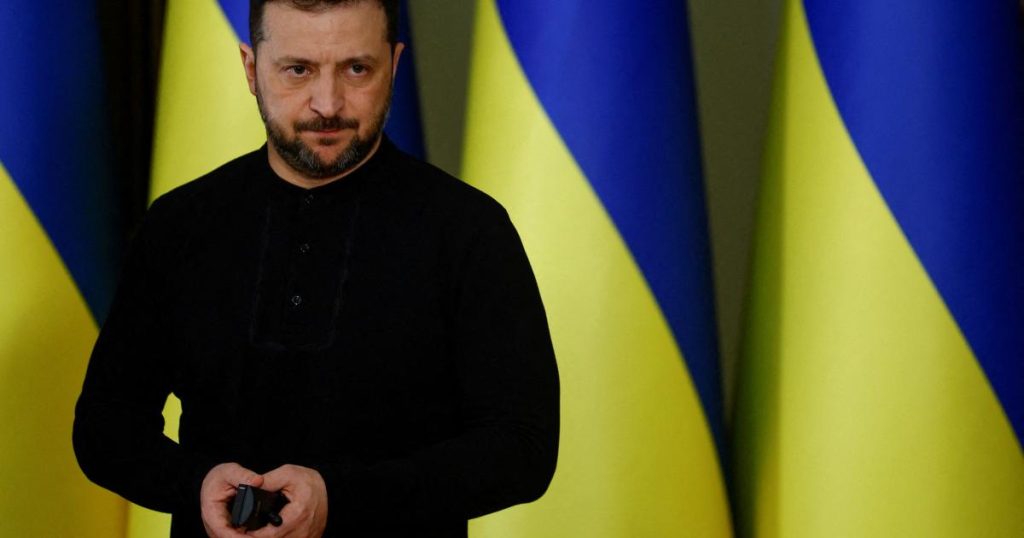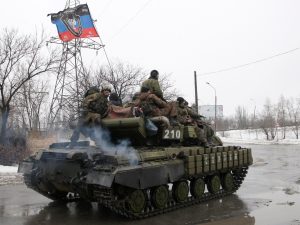Ukraine has considerable leverage in upcoming negotiations with Russia—as long as the United States stands by Kyiv and adopts a negotiating strategy that creates real dilemmas for Moscow. U.S. support for Ukraine has been cast into doubt in recent weeks after a flurry of comments by Trump administration officials offering unilateral concessions to Moscow and criticizing Ukraine. Bilateral talks between Russia and the United States in Riyadh have heightened concerns in Ukraine and Europe. But these moves are a choice, not a necessity. A good deal is still within reach if Washington is willing to pursue it.
The Trump administration should enter these negotiations with a clear sense of U.S. interests, a correct diagnosis of the problem to be solved, a preferred ranking of possible outcomes, and a strategy for how to accomplish its objective. If it does that, it can secure a free and independent Ukraine with the ability to defend itself and deter future attack. If the United States fails to help Ukraine exploit the advantage it has on the eve of talks, it will give Moscow a lifeline, which it will not just use in its quest to dominate Ukraine but also to damage U.S. interests globally.
RUSSIA UNDER PRESSURE
In its final year, the Biden administration, in which I served as senior director for strategic planning at the National Security Council, prepared Ukraine for talks in 2025 regardless of who won the U.S. election in 2024. After the unsuccessful counteroffensive of 2023, the administration helped Ukraine create three vectors of action that would weaken Moscow’s ability to prosecute the war indefinitely and thus put pressure on it to negotiate seriously.
One vector was to support a strategy of asymmetric attrition. According to the Department of Defense, Russian casualties are over 700,000 since the war began and averaging 1,500 a day. Moscow’s attempts to open up a new pipeline of troops from North Korea seem to have failed, because North Korean casualty numbers have been so high that Pyongyang has not sent many more. Accordingly, if he wants to fight a long war, Russian President Vladimir Putin is facing the prospect of having to order a mobilization later this year, which he has tried to avoid in order to shield ordinary Russians from the reality and pain of the battlefront. The second vector was support of Ukraine’s long-strike campaign, initially through backing its indigenous drone program and then with the provision of long-range ATACMS. And the third was the ramping up of sanctions on Russia, including on 50 banks and on its energy sector, in order to complicate Moscow’s ability to finance a long war; one effect was a spike in Russian inflation, which exceeded 9.5%, with interest rates over 21%, at the end of 2024.
The United States also sent enough artillery rounds, rockets, air defense, and fighting vehicles to put Ukraine in a position to fight through 2025. A $50 billion allied loan, leveraging frozen Russian sovereign assets, has given Ukraine a financial lifeline. The result is that Russia is stuck. Moscow still seeks to dominate Ukraine, but it is gaining only slivers of territory in eastern Ukraine with very little prospect of making sweeping gains. It failed to cause Ukraine’s collapse through energy strikes over the winter. It still has not regained all of the Russian territory seized by Ukraine in Kursk, more than six months after Ukraine’s incursion. And all of this has been compounded by the fall of its ally Bashar al-Assad in Syria and the likely end of its military presence there.
WHY UKRAINE MATTERS
There are some observers and policymakers, including in the Trump administration, who believe that the outcome in the war in Ukraine matters little to the United States and that European security has been a distraction to the primary U.S. strategic challenge of countering China. Yet even if one views U.S. national interests through the prism of “America first” and sees little value in preserving a rules-based order or bolstering NATO, the United States has at least four core interests in preventing Russia from winning in Ukraine and in ensuring a free and sovereign Ukraine.
First, since the war began, Russia has significantly deepened its cooperation with China, North Korea, and Iran. It has received critical assistance from each—including machine tools, microelectronics, and coproduction partnerships to help reconstitute its military from China; missiles and drones from Iran; and artillery and soldiers from North Korea. In exchange, the Kremlin has provided unprecedented military and technological assistance to each, far beyond what it had previously considered. This cooperation is enduring and poses a real threat to U.S. interests. If Russia prevails in Ukraine, it will be a victory as well for each of its three partners, without whom Moscow would have already lost. This alignment of U.S. competitors and adversaries would deepen, as Russia’s partners receive their quid pro quo. There is no prospect of a peace deal driving a wedge between Russia and China—the bond between their leaders is too strong. China, in particular, will be emboldened by a Russian victory, and could draw conclusions about the willingness of the United States to stick with a partner through thick and thin.
Second, the survival of a free and independent Ukraine will be good for the United States. The Ukrainian military will emerge from the war as Europe’s third largest, after Russia and Turkey. It has pioneered cutting-edge technological developments, especially on drone warfare and the application of artificial intelligence to warfighting. It will share this technology with the United States and help Europe reconstitute its defense industrial base. The United States has already learned a great deal about the future of warfare from Ukraine. Ukraine is likely to be a strong and reliable ally for the United States in other parts of the world, including the Indo-Pacific, where it can advise and strengthen U.S. allies.
Third, a Russian victory in Ukraine would significantly increase the threat to several European states that are staunchly pro-American and spend a high percentage of their GDP on defense. These include Lithuania, which has pledged to spend over five percent of its GDP on defense in the next two years; Poland, which is on track for 4.7%; Latvia, which is at 3.45%; and Estonia, which is at 3.2%. Western European countries will not have sufficient capability to deter Russian aggression for many years, even if they immediately ramp up defense spending, and they are also likely to lack the willpower. The United States should not be abandoning an alliance commitment to sovereign nation states that are doing everything Washington asks because others in western Europe are not doing more.
Finally, and perhaps most important, the United States has an interest in a stable and peaceful Europe. Europe is the United States’ largest source of foreign investment and largest export market, and a key ally that broadly aligns with the United States on the central issues in world politics. If the negotiation goes wrong and results in a Russian victory, it will create a geopolitical black hole in Europe—one that would not be neatly siloed off from the rest of the world. This could include sowing the seeds of future conflicts that could spread beyond Ukraine, weakening pro-American states in Europe, and providing Russia with the opportunity to project power globally in a manner detrimental to U.S. interests, including in the Middle East, Africa, and the Indo-Pacific.
REDLINES
The primary problem that has to be solved in negotiations is that Russia wants a neutral and weakened Ukraine, whereas Ukraine wants sufficient security capabilities and guarantees so it can deter and defend against any future attack.
In a speech to his own Ministry of Foreign Affairs in June 2024, Putin articulated a firm stance that “Ukraine should adopt a neutral, non-aligned status, be nuclear-free, and undergo demilitarization and denazification,” and demanded that Ukraine cede the entirety of Donetsk, Luhansk, Kherson, and Zaporizhzhia provinces. In a number of interviews since, he has affirmed that position and described Ukrainian President Volodymyr Zelensky as an illegitimate leader of Ukraine with no authority to sign a treaty to end the war. Putin has also demanded strict limits on the size and scope of Ukraine’s military, including a prohibition on “offensive” weapons, an effective Russian veto over any international security guarantees provided to Ukraine, and western security assurances for Russia.
Such an outcome would (and should) be completely unacceptable to Ukraine and its partners. No Ukrainian leadership can accede to regime change and massive limits on its ability to defend itself. Kyiv needs some arrangement that can dissuade Russia from resuming the war at a moment of its choosing. The Ukrainian government’s official position is that it wants all of Ukraine’s sovereign territory, including Crimea, back, as well as membership in NATO, so that Russia could not attack it again without triggering a wider war. There are, however, indications that Ukraine would be willing to accept a freezing of the territorial line if it came without legal recognition of Russian gains and if allies supported Ukraine’s right to regain the territory by nonmilitary means. Most important for the Ukrainians, it would be compensated with ironclad security guarantees for the rest of the country and with a pledge of political and economic integration into the West.
Accordingly, the task for the United States and its allies should be clear: to work with Kyiv on an outcome that would provide for a free and independent Ukraine with the ability to defend itself and deter a future attack, and then to persuade Putin to accept it.
TELL ME HOW THIS ENDS
The various parties to the negotiations have put forward four distinct end states, each with its own logic and implications, not all of which have been properly understood. The first is NATO membership for Ukraine, which would provide Kyiv with an Article 5 security guarantee. Although the specific language is somewhat ambiguous, Article 5 has usually been interpreted by the United States (and other NATO members) as an ironclad commitment to intervene directly on behalf of an ally. With such a commitment, Ukrainians believe that Russia would be much less likely to attack again, given the likelihood that doing so would lead to war with the United States. Two variants of membership could apply in this case. Under the West Germany model, Kyiv would join NATO with the understanding that Article 5 applies only to territory under its control and pledge not to use force to retake Russian-occupied territories. Under the Norway model (based on the approach to that country’s membership at NATO’s founding, in 1949), it would agree to self-imposed limits on foreign bases, troops, naval vessels, and equipment that would be present in country—drawing a distinction, in other words, between Ukraine in NATO and NATO in Ukraine.
The second end state is what has been called the Israel model, with Washington providing enough military and intelligence assistance to enable Ukraine to deter and, if necessary, defeat Russian forces without direct intervention by other nations. In the case of Israel, U.S. support is based on various memorandums of understanding that aim to provide it with a Qualitative Military Edge (a technological military advantage over its neighbors). This would not apply in the case of Ukraine, but the United States could aim to give it a credible defense and deterrence capability, as the 2024 U.S.-Ukraine Bilateral Security Agreement put it. This would not be just what is sometimes referred to as a “porcupine strategy,” which implies a purely defensive position. It would provide Ukraine with the ability to use long-range missiles, such as ATACMS and JASSMs, to go on the offensive inside of Russia and elsewhere in the event that Russia invaded again.
In practice, the Israel model would require the United States and allies to commit to helping Ukraine build a force that would include layered air defense, an air force that included a significant number of F-16s, stockpiles of 155 munitions and medium-range missiles such as GMLRs, a trained force capable of combined arms operations, robust defenses along the line of control, long-range missiles, and a resilient and cutting-edge defense industrial base to produce as much as possible in country. The United States could also promise to provide Ukraine with indirect support if it were attacked again, along the lines of U.S. support for the past three years except with no restrictions on Ukrainian use of U.S. weapons.
A free and independent Ukraine will be good for the United States.
A third end state would center on a European security guarantee. Trump’s national security adviser, Mike Waltz, recently told NBC that the matter of security guarantees is “squarely going to be with the Europeans,” raising the question of whether European countries could send troops to Ukraine after the war. It is unclear, however, what the purpose of such a deployment would be. Would the troops serve as a tripwire force to deter a future Russian invasion? In that case, European nations would be at war with Russia. Are they there to train Ukrainian forces and help in the recovery, but not as a deterrent force? In that case, they would have to leave the moment a new invasion seemed likely. U.S. Secretary of Defense Pete Hegseth made it clear that if European troops did go to Ukraine, they would be operating without a U.S. guarantee. Some Europeans worry that this would give Putin an opportunity to drive a wedge between the United States and Europe—if he targeted European troops, NATO’s European members would be at war with Russia without U.S. support. For his part, Zelensky has stressed that “security guarantees without America are not real security guarantees.”
The fourth end state would hinge on Ukraine’s neutrality, a demand that Russia is likely to begin any negotiation with, building on discussions in Istanbul in 2022. The key question would be what happens if neutrality is violated. Here, it is worth looking at Istanbul closely: Moscow proposed that Ukraine would not join any alliances, that the size of its military would be limited, and that security would be guaranteed by a group of countries committed to aiding Ukraine in the event of an attack. But this provision was structured to give Russia an effective veto—in other words, there was no enforcement mechanism.
Other approaches to neutrality would not work, either. In the case of Finland, after World War II, the Soviet Union was able to interfere with both foreign and domestic policy, exerting considerable control for several decades. For Austria during the Cold War, neutrality was largely respected, but mostly because a Soviet violation would have come in the context of an invasion of western Europe, triggering a major U.S. response in any case. And Belgium, which was supposed to serve as a neutral buffer with no assistance from other powers, was invaded in both World War I and World War II.
THE KREMLIN’S DILEMMAS
In approaching these possible end states, the U.S. strategy should be to create a dilemma for Russia over the type of Ukraine that it could face. The Trump administration has taken a very different view, but Washington could and should categorically rule out neutering Ukraine or formal neutrality, and instead put three options on the table: a Norway model of NATO membership, the Israel model, and a European Security Guarantee.
Each of these options has significant downsides for Russia. There is a plausible argument that the Norway model of NATO membership could be more palatable to Moscow than the Israel model or European troops, especially if it opened up the possibility of a broader discussion on some limits on Ukrainian offensive weaponry and on European architecture. These are things that would normally be rejected by Ukraine and the allies but could be discussed and considered by the alliance in the event that Russia accepted Ukrainian membership of NATO. Moreover, under the Norway model, there would not be NATO troops in Ukraine and its government would be somewhat restrained by its allies.
The Israel model, by contrast, would mean a heavily armed and insecure Ukraine that would have to fend for itself and thus be prone to anticipatory self-defense and unilateral kinetic action in the form of sabotage, covert action, and assassination. Adding enhanced indirect support would mean that if Russia ever invaded again, the United States would provide military and intelligence assistance to Ukraine, as it has done for the past three years, but with no restrictions on the use of allied weapons inside of Russia.
The presence of European troops would mean that, in addition to Ukrainian rearmament, Russia would have to contend with NATO member state forces closer to its border with the ability to monitor its troop movements and train the Ukrainian forces in country. The Kremlin might take comfort in the fact that Europe is not ready to carry out this mission, but it would surely worry that a future U.S. administration would provide these troops with a security guarantee.
Washington could and should rule out formal neutrality for Ukraine.
The goal in a negotiation should be to compel Russia to confront the dilemmas it faces and to test the limits of what it can tolerate. Russia is likely to reject the Norway model, but the United States could then turn to the Israel model—preferable to a deployment of European troops that the Europeans themselves are not ready to execute effectively. In short, although Plan A should be the Norway model, the Israel model would be the fallback as Plan B.
Russia could, of course, reject the Israel model, as well as NATO and a European guarantee, and stick to its maximalist goals. That’s why the United States should continue to support Ukraine and maintain pressure on Russia, especially through asymmetrical attrition, which would make it difficult for Russia to wage a long war. The Trump administration will be reluctant to request new military assistance for Ukraine from Congress, although doing so would send an important signal to Moscow. Meanwhile, proposals that European governments purchase U.S. weapons for Ukraine will face objections in the Pentagon given how low U.S. inventories are and because of demands from other regions. One way to overcome both of these problems would be through legislation funding general munitions production, sending the signal that the defense industry should ramp up production—for the Indo-Pacific and the Middle East as well as for Europe. Some of this production could then be provided by the United States in exchange for a deal on access to critical minerals or purchased for Ukraine, funded by European governments using frozen Russian assets.
Russia, for its part, is likely to ask for punitive sanctions to be lifted and the $300 billion in frozen sovereign assets returned. These demands should be mostly rejected, with the bulk of sanctions remaining in place as long as Russia illegally occupies Ukrainian territory. (The sanctions have the added benefit of impeding deeper economic ties between Russia and China.) If the Trump administration insists on lifting sanctions, at the very least it should keep in place those that impede Russia’s military modernization, such as on microelectronics. The sovereign assets should be transferred to Ukraine in lieu of reparations, to be used for reconstruction and a rebuilding of its military. This does not need to be agreed to by the Russians; European states have the power to make the move unilaterally, since the vast bulk of the frozen assets are there.
GOOD ENOUGH
If it backs Ukraine in negotiations and uses the leverage available to it, the Trump administration could secure the Israel model for Ukraine—the construction of a powerful future force with the ability to strike Russian territory if it were attacked, backed by a promise of indirect U.S. support in the event of a new war. This deal would not be perfect, as it leaves Ukraine without external security guarantees. Although there may have been a pathway to NATO, along the lines of the Norway model, under a Democratic administration, such an outcome is clearly not acceptable to President Trump. (It could still be taken up by a different U.S. administration in the future.) The Israel model provides a viable pathway to a free and independent Ukraine with the ability to defend itself and deter future attack. And over time, it may serve as a stepping stone to a more durable and just peace.
Loading…









